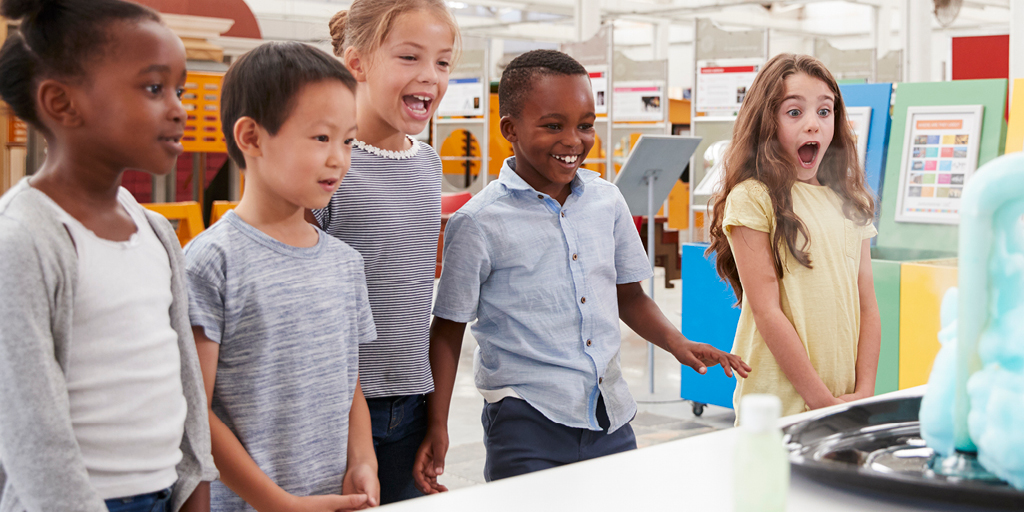
Just this past week, I asked a fourth-grade student to help another student get caught up on a research project. The two students came to my classroom and sat down at the computer. My helper Kristie sat down next to Robbie and I could instantly see a change. She morphed from student to teacher before my very eyes. As Kristie sat very patiently and kindly working with Robbie, I was amazed—and once again reminded of why I am a teacher. Moments like these, where you see a student using his or her skills, collaborating, and going above and beyond expectations, are the moments we teachers live for. And at this very moment, I was reminded again that I learn at least as much from my students as they learn from me.
Here are 10 lessons that my students have taught me over the years:
- Don’t judge a book by its cover. This is a great lesson both in teaching and in life: Don’t judge someone by their appearance. Sometimes the kids who look disinterested or are bouncing off the walls are still listening. Later in the class period or even weeks later, a student may say something that tells you they understood. My favorite example of this is a student named Alicia who I first taught when she was a junior in high school. Each day for a good part of first semester, she plopped her backpack down on her desk and refused to be seen. But we got to know each other and built rapport. And guess who I still keep in touch with today? Alicia. However, if I’d written her off when she was seventeen, I’d never know what a cool person she would grow into.
- Patience, patience, and more patience. Need I say more? But seriously, each day offers us the chance to practice patience and learn self-control. Picture this: You are teaching a kindergarten computer class and have one child under a table who won’t come out, so you’ve had to call in help. As one class leaves the computer lab, a new class enters. You’re trying to extract the kid who’s under the table, and the other students can’t help but watch the chaos. Meanwhile, another kid is barking like a dog on the rug. All the while, you’re trying to get the new class started on their assignment. This is only one of many examples (and yes, this did happen to me) where patience comes into play in a classroom. As educators, we can let the challenges break us or we can have a little sense of humor, remember that kids are kids, and work our butts off to remain calm. We won’t be perfect, but after a few years in education, we’ll be much better at being patient during stressful situations.
- Celebrate even the small victories. In my first-grade computer classes, I’ve been teaching students their name logins—the longer, harder way to log in to their computers. All but one of my students had this down. Finally, the last boy to master this skill did it all by himself after months of trying. We gave him a round of applause, and I did a happy dance. I was so proud of his accomplishment and wanted us all to celebrate. I think it’s a good practice to celebrate the small steps that lead to larger accomplishments, and I try to remember this as I teach.
- Be flexible. If you’re currently an educator and you’re reading this, then you have learned to be flexible at work. As teachers, we have to change our schedules, adjust lessons, and add new students to our rosters almost daily—and usually on short notice. We learn the ability to make quick decisions and go to Plan B when Plan A is no longer an option. We learn to be flexible with our co-workers and with our students—to go with the flow, so to speak. We must do this to survive in education. For instance, if we have a student at the door crying, our plans to begin our lesson may have to take a backseat to the crisis at hand. Even though learning to be flexible can be hard, I am glad for the opportunity day after day because I think flexibility allows me to be a better partner, parent, neighbor, and friend.
- It’s okay to say “I don’t know.” I’m pretty sure back in the day teachers were supposed to be infallible. Teachers knew everything—if they didn’t, they pretended they did. But that’s not how educators roll today. If a student asks a question that I am not certain about, I simply say, “I don’t know, but I’ll find out.” This allows for trust and honesty. I am telling my student, “I’m still learning, just like you.” The hard part is that you really must be sure to follow through. I try to write down the question somewhere visible—usually on my whiteboard. Then I come back to the question once I’ve found the answer. In turn, I want kids to know that it’s okay not to know yet. Same as me, I want them to have the skills to go out and find the answers to their questions.
- Everyone makes mistakes. This lesson goes hand in hand with lesson five. Students also need to know that everyone makes mistakes, even teachers—maybe especially teachers. When students call me out on something that I’ve messed up on, I say, “I made a mistake.” This helps model to students that mistakes are part of life and we are not defined by them. I try to be honest about my mistakes and even laugh at myself when I do something silly. I try to let my students see me as a human, to see that I make mistakes and also move past them.
- Everyone matters. This may be the most important lesson of all. When students leave my class, I want them to know that I think they matter. They remind me of this all the time, especially when I’m frustrated and losing my patience. I just need to slow down, think about the student, look at his or her struggles and accomplishments, and then I remember that he or she matters. The kid who interrupts. The kid who is off task. The kid who is crying in the corner. They are all important. And when I am cognizant that each student matters, I am better able to treat each student with dignity. In turn, I want them to treat each other in this same way—as if each fellow classmate matters and deserves respect.
- There are days when you just need to stop what you’re doing and give a hug. When I was at my first teaching gig, I was a bit standoffish. I wasn’t comfortable stopping a lesson to comfort a student, give a hug, or just talk. But now that I teach elementary kids (and I believe this applies to older students as well), I know that there are times I have to just pause a lesson and give a kid some affection. The kids who are the huggers—the ones who will hug you a million times a day—obviously need the hug, and sometimes the kid who looks down or who just shared a truth about his or her life also needs some comfort and attention. I’ve learned to reach out to hurting students, even if that throws off my lesson plan.
- It is important to communicate and clarify. I’m pretty sure we all learn this on day one of teaching and keep having this lesson served up to us, no matter how good we are. Imagine this: You have just explained how to do a math problem. The students seem to be following along. They go to do the math problem themselves and are instantly stuck. We have to learn to communicate appropriately to the students we are working with, clarify if they don’t understand, and repeat as necessary. Sometimes we think students understand, but they don’t. Homework and tests tell us right away what we need to tweak in our teaching, and we need to be constantly attentive to ways to better communicate a concept. We also have to be honest with ourselves that maybe it’s the way we taught something that confused our students and try again.
- Bad actions don’t equal bad students. I am thinking of Chad—a fourth grader who is smart and funny, but some days he’s a whole lot of kid. I really care about Chad, but sometimes his impulsivity gets the best of him and he makes poor choices. Chad generally accepts his consequences, but sometimes his face says that he feels like he’s a bad kid because he has gotten into trouble. The thing is, all students make mistakes. Even the best and brightest are going to make poor decisions from time to time. I try to remember that even the hardest students, including those who act out the most, are not bad. They are students who, like us teachers, are struggling. I try to remember this and share with students when they mess up.
The longer I’m in education, the more I am aware of the lessons I have learned from my students. Teaching for 20 plus years has impacted me—it’s made me more patient, more mindful, and more empathetic. And even though teaching is hard, I can’t imagine doing anything else.
Want to connect with fellow educators to discuss teaching topics and trends? Consider joining MimioConnect™, our online educator community.
Note: Names have been changed to protect the privacy of my students.





